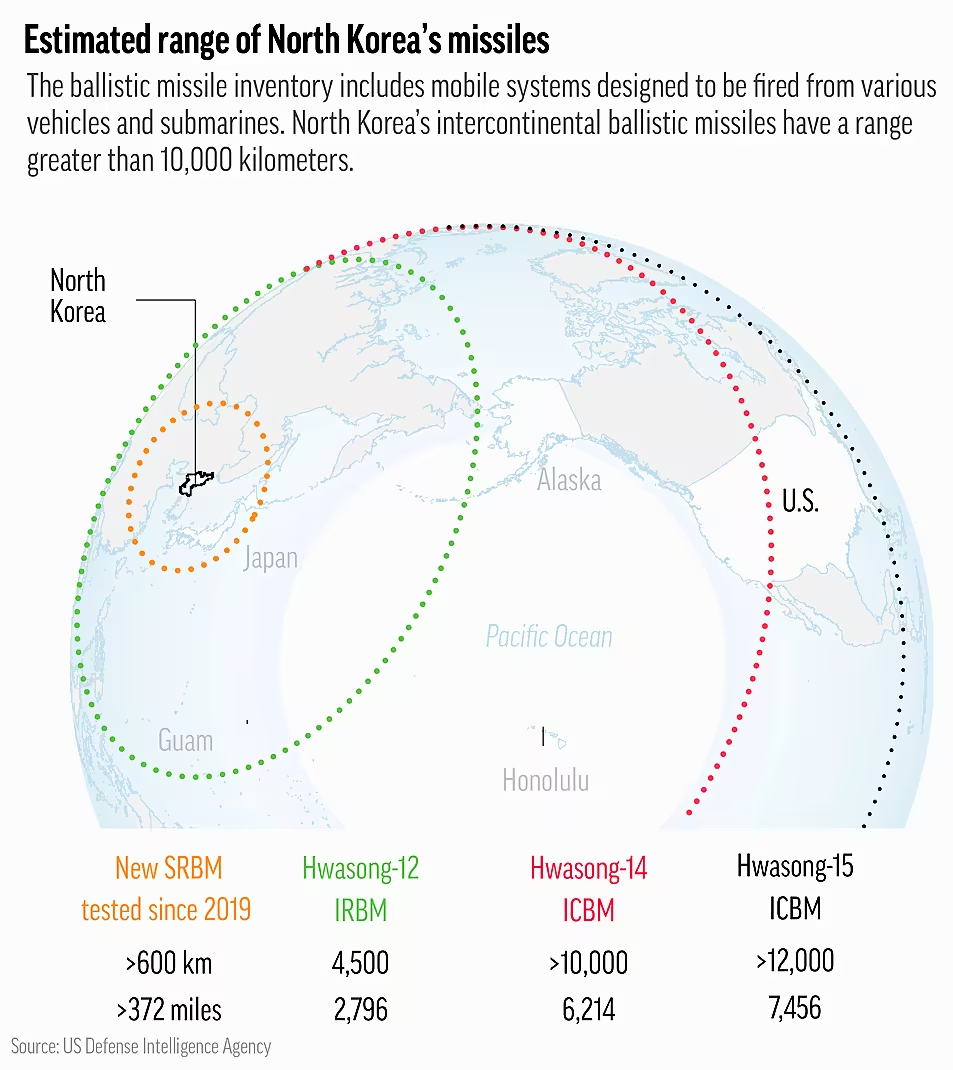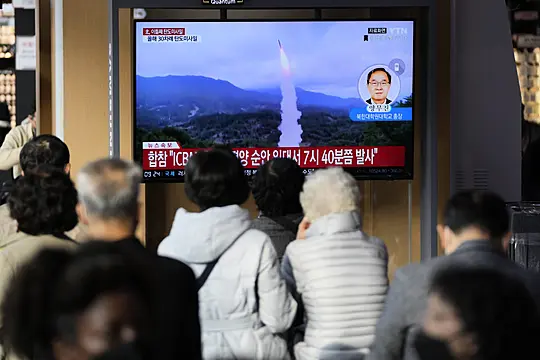North Korea have fired at least six missiles into the sea, including an intercontinental ballistic missile (ICBM) which triggered evacuation warnings and halted trains in northern Japan.
It adds to a recent barrage of weapons tests that has escalated tensions in the region.
Thursday’s ICBM test was followed by launches of two short-range ballistic missiles in the morning, drawing swift condemnation by North Korea’s neighbours and the US, which reacted by extending joint air force exercises with South Korea.
The South Korean and Japanese militaries said North Korea later fired three more short-range missiles into waters off its eastern coast.
Those launches came an hour after a senior North Korean military official issued a statement threatening retaliation over the extension of the US-South Korea drills. It was not immediately clear how far those missiles flew.

The launches are the latest in a series of North Korean weapons tests in recent months that have raised tensions. On Wednesday, North Korea fired more than 20 missiles, the most it has launched in a single day.
Experts say North Korea is escalating a brinkmanship aimed at forcing the US to accept it as a nuclear power and negotiating economic and security concessions from a position of strength.
The US said in response to the launches it is willing to take “all necessary measures” to ensure the safety of the American homeland and allies South Korea and Japan. The Biden administration also warned of unspecified “additional costs and consequences” if North Korea goes on to detonate a nuclear test device for the first time since September 2017.
Earlier on Thursday, South Korea’s Joint Chiefs of Staff said it detected North Korea had fired an ICBM from an area near its capital, Pyongyang, at about 7.40am and then two short-range missiles that flew towards its eastern waters an hour later from the nearby city of Kaechon.
The longer-range missile appeared to be fired at a high angle, possibly to avoid entering the territory of neighbours, reaching a maximum altitude of 1,193 miles and travelling around 472 miles, according to South Korea’s military. It was not immediately clear if the launch was successful.
Japan’s military announced similar flight details. It also said it lost track of one of the North Korean weapons, apparently the ICBM, after it “disappeared” in skies above waters between the Korean Peninsula and Japan. South Korea said the short-range missiles travelled about 91 miles, falling closer to North Korea’s eastern coast.

Choi Yong Soo, a South Korean navy captain who handles public affairs for Seoul’s Defence Ministry, did not answer directly when asked about the possibility of the ICBM launch being a failure, saying that it is still being analysed.
Citing anonymous military sources, South Korea’s Yonhap news agency said the missile possibly failed to maintain a normal flight following a stage separation.
The Japanese government initially feared North Korea fired a missile over its northern territory but later adjusted its assessment. Japanese chief cabinet secretary Hirokazu Matsuno said the alerts were based on a trajectory analysis that indicated a flyover.
The office of Japanese prime minister Fumio Kishida broadcast the “J-Alert” warnings through television, radio, mobile phones and public loudspeakers to residents of the northern prefectures of Miyagi, Yamagata and Niigata, instructing them to go inside strong buildings or underground.
There have been no reports of damage or injuries in the regions where the alerts were issued. Bullet train services in some areas were temporarily suspended following the missile alert before resuming shortly.
North Korean missile activity is a particular concern in Niigata, which is home to seven reactors at the Kashiwazaki-Kariwa nuclear power plant. Those reactors are currently offline and Japanese authorities say no abnormalities have been detected.

On Sado island, just off Niigata’s northern coast, fishermen rushed back from sea at the sound of sirens blaring from community speaker systems. One fisherman told NTV television he no longer feels safe going out to sea.
“We really have to be careful,” he said.
North Korea last flew a missile over Japan in October in what it described as a test of a new intermediate-range ballistic missile, which experts say potentially would be capable of reaching Guam, a major US military hub in the Pacific.
Mr Kishida condemned North Korea’s latest launches and said officials were analysing the details of the weapons. The office of South Korean President Yoon Suk Yeol said his national security director, Kim Sung-han, discussed the launches during an emergency security meeting at which members talked about plans to strength the country’s defence in conjunction with its alliance with the US.
The office said South Korea will continue combined military exercises with the US in response to North Korea’s intensified testing activity, which it said will only deepen the North’s international isolation and unleash further economic shock to its people.
Adrienne Watson, a spokeswoman for the US National Security Council, issued a statement saying the US strongly condemns North Korea’s ICBM test and that President Joe Biden and his national security team are assessing the situation in close co-ordination with allies and partners.

“This launch, in addition to the launch of multiple other ballistic missiles this week, is a flagrant violation of multiple UN Security Council resolutions and needlessly raises tensions and risks destabilising the security situation in the region,” Ms Watson said.
One of the more than 20 missiles North Korea shot on Wednesday flew in the direction of a populated South Korean island and landed near the rivals’ tense sea border, triggering air raid sirens and forcing residents on Ulleung island to evacuate. South Korea quickly responded by launching its own missiles in the same border area.
Those launches came hours after North Korea threatened to use nuclear weapons to get the US and South Korea to “pay the most horrible price in history” in protest of ongoing South Korean-US military drills it views as a rehearsal for a potential invasion.
Following North Korea’s additional launches on Thursday, the South Korean and US air forces agreed to extend their ongoing combined aerial drills to step up their defence posture in the face of North Korea’s increased weapons testing and growing nuclear threat.
US and South Korean forces have deployed more than 200 warplanes, including advanced F-35 fighter jets, for the Vigilant Storm exercises initially scheduled until Friday. South Korea’s air force did not immediately say how long the training will continue, noting the allies are still discussing details.
In a statement issued through state media, senior North Korean military official Pak Jong Chon accused the allies of pushing tensions to an “uncontrollable state” by extending their “provocative military acts”.

“The US and South Korea will get to know what an irrevocable and awful mistake they made,” he said.
North Korea has been ramping up its weapons demonstrations to a record pace this year. It has fired dozens of missiles, including previous ICBM launches in March and May, as it exploits the distraction created by Russia’s war in Ukraine and a pause in diplomacy to push forward arms development and dial up pressure on the US and its Asian allies.
North Korea has punctuated its tests with an escalatory nuclear doctrine that authorises preemptive nuclear attacks over a variety of loosely defined crisis situations. US and South Korean officials say North Korea may up the ante in the coming weeks with a nuclear test, which would be its seventh overall.
Experts say such tests could bring North Korea a step closer to its goal of building a full-fledged arsenal threatening regional US allies and the American mainland.
“Should it go forward with a seventh nuclear test there would be additional costs and consequences,” State Department spokesman Ned Price said on Tuesday, adding the test would be a “dangerous, reckless, destabilising act”.
Nuclear disarmament talks between Washington and Pyongyang have been stalled since 2019 because of disagreements over an easing of crippling US-led sanctions against North Korea in exchange for its denuclearisation steps.







